Casual Connect Seattle - Tuesday
I'm still working on Texas time, so I was up and at 'em around 5am. And downtown Seattle doesn't stir until around 9, so I found myself with a little time to hike and sightsee. For those unfamiliar with downtown Seattle, it does tend to get a mite cold at all times, even in July. Mornings are pleasant, but the city is situated with the streets pointing to the bay. It's quite nice in the summer, as the cool North Pacific breezes work their way through the city. I can't imagine what it's like in the Winter, though. I think I'd prefer to stay in Texas from October to March.

In downtown Seattle, the streets all head downhill to the waterfront.
If you look across the street, you'll see the "Triple Door", which is a little concert venue used for some of the sessions.
There are plenty of coffee places. And by that I mean that there's a coffee place every hundred feet or so. And I'm only exaggerating a bit. Why a cold place like Seattle got famous for pushing a product that's grown in the equatorial tropics is something I won't get answered for this trip.

This latte was just so artfully swirled that I had to get a picture.
And it won't get answered because this week we're all about casual games!
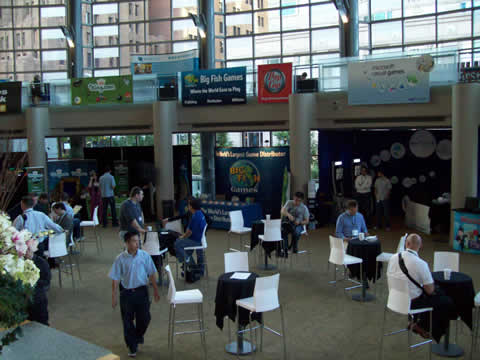
Tuesday started off with two keynote speeches. First off. . .
A Leader's Perspective on Building Value - Jeremy Lewis, CEO of Big Fish Games.
To be honest, I'm not sure I can convey much of a take-away from this speech. It's pretty high level and feel-goody. The first ten minutes were mostly bio and photos. But here are the bullet points.
- Make Culture A Top Priority - Big Fish is working hard on creating a culture around their games.
- Have and Communicate A Vision - Push forth a focus and direction. Build a clearly-defined and concise vision for your company.
- Set Lofty Goals - Develop your own techniques and work on your terms. If you call yourself a global leader and imitate other companies, then you won't reach your lofty goals. On a related
note, BFG is sponsoring a developer contest, and the prize will be a climb of Mt. Rainier.
- Expand The Audience - This is a lot easier said than done. BFG is clearly moving to court women gamers, as he repeatedly references the audience as "she". Strategic partnerships are an
important part of this. Related to this, BFG just announced a partnership with People Magazine - again courting the "Chief Household Office" (i.e. women).
- Reputation Matters - Choose your associations carefully and ensure alignment of interest. Read the fine print.
- Focus On The Numbers - Compete on the analytics. Numbers allow you to make dispassionate decisions. Make decisions based on what you know rather than what you think you know.
- Put Your Ego On The Back Burner - Humility is a key variable that affects leadership credibility. Leadership is in the eyes of those being led. Listen to those who's opinions differ
radically from yours.
- Manage Growth - Growing is one thing, but sustaining growth is a whole different dynamic. While you're growing, it's easy to live by the delusion that everything's going well.
Games are integral to the very being of people. We, as an industry, have a limitless potential to create value.
Building games developed and intended to be played in the West by Tom Prata - Game boss for Nintendo for "International" (i.e. non-Japan) games.
Somehow graphical performance became the determinant as to what would make the best quality games. The mission became "Expanding the Game Population", and this was not done with improved performance but with expanded markets and less complicated gameplay. People were losing interest because games were becoming more complicated. They felt that the newest games weren't for them. Hence the prices dropped despite growing development costs.
Expand the market - US participation in gaming is growing. In the last 2.5 years, 30 million new game players have been added. The opportunity is still there, though. Given the right game, there are another 150 million players who would play.
Price pressure is an issue, especially when you're competing against games that are free.
Focus on quality and that which is different. Players decide what is good and what is great. And this quality leads to word-of-mouth.
"Go For Different" was the model they went with for the DS and the Wii. Experience was broadened to include more than just performance.
Wii Fit has become the best-selling game in the world, despite carrying a retail price of $90.
"I wanted to make something very unique. Something very different" - Shigeru Miyamoto
Miyamoto's Method - The creativity behind the games is the important things, not the big franchises (Mario, Zelda).
- Observation - Observe people and see what grabs their interests and what they're passionate about. Know that things change and things that were popular before may not be later.
- Find a "Universal" Theme - Don't just make a product for yourself. Look for the core concept that's appealing and universal.
- Analysis - Find the "central compelling element" that will attract people to your product.
- Proof of Concept - show that that "core element" is interesting. This is done as an actual prototype, not just on paper. The concept is tested with a small team.
If there's an underlying problem with the core premise, no amount of bonus items or levels will fix the problem. Learn from mistakes.
In 2003, there was an experimental product called "Stage Debut". It allowed you to take photos of yourself and build a character around it. While interesting and funny, the team couldn't make the demo gel as a game. They decided not to turn it into a product, but the experiment ended up becoming the "Mii" concept.
Three key attributes in games with wide appeal. Nintendo always keeps these in front.
- Accessibility - Focus on the broader market and things that appeal to everyone. Wii Sports needed to focus very hard on this. Rather than building several fully-featured games, they took
smaller games with a good Wiimote gameplay experience. People could easily relate to the Wiimote's connection to the sports.
- Sense of Newness - Products must surprise and delight. Otherwise you'll reach a saturation point. This is the secret to keeping life in older franchises.
- Consumer Reaction - It's not about what we think, but what they think. See your product through the eyes of the consumer. If the consumer doesn't like it, it's not the consumer's fault.
In game development, one thing matters - the talent of the game developer. Some of Nintendo's products were created by very small teams. For example, BrainAge is one of their biggest products, but it was made by six people in a few months.
Determine what you can do with the resources you have, and try to exceed that.
Consumer Reaction - it's not about what we think, but what they think. See your product through the eyes of the consumer. If the consumer doesn't like it, it's not the consumer's fault.
In game development, one thing matters - the talent of the game developer. Some of Nintendo's most popular products were created by very small teams.
Determine what you can do with the resources you have, and try to exceed that.
Casual Connect - Wednesday
We got down to a little more work on Wednesday. One comment (complaint) about Casual Connect this year is that it's ALL business. There were very few programmer-oriented sessions, and pretty-much nothing resembling source code appeared anywhere. There were a few booths for developer tools here and there, but it was mostly about business.

Wow, there's something you don't see in the summer in Texas, fog!
The gray "Pig Truck" is a barbecue sandwich place that was quite popular around lunchtime.
"iPhone crashes the portable gaming party" panel
Jason Loia of Digital Chocolate moderated the panel. His opening point was that the iPhone is blurring the developer-publisher relationship. In the past 12 months, the mobile publishing industry has really been put on its head. The model for purchasing digital content for mobile has certainly changed with the instant popularity of the iPhone App Store.
Cross platform and multi-platform development is important with a core "center of gravity" platform and several ancillary platforms also in development.
iPhone and iPod Touch user base is currently at about 46 million units. Nintendo DS is over 100 million. This quarter, iPhone/iTouch sales exceeded those of PSP.
About 20% if the apps on the iPhone are free. The current rate is about 300 new games per day. In the course of one year, 68,000 apps have shipped and 1 billion apps have been downloaded.
If you're targeting iPhone, don't neglect iPod Touch users. They skew to a younger demographic and, despite fewer of 'em out there, they download almost as many games.
The real cost of development isn't just overcoming technical hurdles. The context of user experience between the DS and iPhone is quite different. And the price-point is also quite a bit different. People don't expect as deep an experience on a $2 iPhone game that they do on a $40 DS game, despite the similarity of platforms. Games are structured differently between DS and iPhone, and that's not just due to the tech. The depth of the game (20 hours vs 20 minutes) is quite different.
One of the big values of the iPhone is the app store, as you don't have to work through carriers and deal with their systems.
Cost of goods is also an issue. The intrinsic cost to get a DS game on the shelves is $6-$8 with a 14-28 day backlog at manufacturing. The physical goods and costs component must be taken into account.
The top-ranked game on the app store is getting 25k-40k installs per day.
Microtransactions and subscription content on the iPhone is ready, ad the future of the platform is going to be the 99-cent game. In order for microtransactions or subscriptions to be available, the game cannot be free, so you need to go with the lowest price-point.
Remember that you're competing with disposable apps with a very short shelf-life.
Successful entities are the ones creating a franchise - the Hulu model vs the YouTube model.
How do you take something that's done well on other platforms and get 'em successful on the iPhone? Try to reimagine the experience for the iPhone. Take full advantage of iPhone 3.0 features. Don't just port it. Don't just count on the hottest franchises becoming the hottest iPhone titles. The Sims on iPhone was knocked off the number-one spot by "Sally's Spa".
Kongregate - Fatal Flaws in Flash Games
Kongregate - 16,000 games and 1,000 uploaded monthly. Audience is primarily young males.
The top games make up the lion's share of the traffic. The top 10% of the games get 90% of the play-time, and the top 1% of games get half of the traffic.
High ratings are the key to multiple plays. They differentiate between regular players (5 plays/month) and addicts (20 plays/month).
Achievements are not a key to improving a game's rating. Achievements and badges drive traffic to a game, but they give gamers a longer experience, and they'll often rate it lower because not getting lots of achievements frustrates players.
(Lots of reading of bar-charts to us. Some of the annotation is interesting, but it doesn't change the fact that I'm being read to.)
General mistakes you can make in your designs.
- Have a mute button and a pause button. Some users are fanatical about it.
- Keep the mechanic simple and build on that. Make sure it's fun from the onset, as you can't insert the fun later.
- The final product matters, not the amount of time spent on it.
- Don't concentrate on game length. Some of the best games are the shortest and some of the most frustrated comments come from games that are unnecessarily long. Don't add filler if you think your
game is too short.
- Players do not read the instructions. If your players do not understand the controls, that's your problem and not theirs. Allow flexibility for controls. "Super Energy Apocalypse Recycled" is
very popular despite being very complicated and the game itself being about 2/3 tutorial.
- Challenge vs frustration. Making a player randomly die is not difficult. It's just frustrating.
- Art need not conflict with fun. Sprout and Anika's Odyssey are very popular and are text-free, but they're enjoyable.
- Make sure that the most effective strategies to get you to your goal are the most fun. If there's a "cheat" way to play that gets you to the end, you need to tweak your game to get rid of
that.
- Style, aesthetics, and relate-ability win over the technically impressive stuff.
- The final 10% is the most important. Some small tweaks can improve your rating quite a bit.

Most of the panels in the Recital Hall looked like this. It was always humorous to hear a panelist insist that they had the NUMBER ONE game portal on the internet in front of a Big Fish Games banner
that proclaims that they are the NUMBER ONE game portal on the internet.
Mobile Showdown
This was a rather odd panel, as the 800-pound gorilla of mobile phones was not present. Most of the rest of the pack (Android, Blackberry, Windows Mobile, Nokia) were there. And I noticed that the pundits no longer referred to "smartphone" in the context of Windows Mobile (where I'd always heard it used) but as a more generic term for the new crop of uber-powerful phones. So if I use the term "smartphone", it's iPhone/Android/Blackberry/WM/Pre/etc.
Not surprisingly, the legacy phone download market is flat. All of the growth is in the smartphone arena, especially the new phone hosted "app store" (which all the smartphone-makers are implementing) is a great achievement that we should all support. The existing carrier-hosted download stores were a problem for users and phone-makers.
As for non-iPhone app stores, one new name I heard was "Ovi", which is Nokia's new phone-hosted app store. It's not currently popular in the US, but it's growing where Nokia phones are more popular. Windows Mobile Marketplace is also opening next week and promises to offer such an experience.
One important point made by a non-iPhone OS maker (Microsoft I think) is that while the iPhone app store currently owns the market, it will not dominate forever. The industry is still in its infancy and there's plenty of room for more phone-makers.
Smartphones are where you need to be. Wired Magazine recently did a survey, and the number-one piece of tech that people want to upgrade is their phones. And smartphones are overwhelmingly what they want to upgrade to.

The between-session crowd mingles in the foyer of the opera house.
One thing you notice in Seattle is that every building or arthouse or museum that's built with donations has the name of some Microsoft luminary on the "our contributors" wall. There are plenty of
Gates' and Allen's and Simonyi's passing money around to the local projects.
I Have Seen The Future And It Is iPhone
In contrast to the previous panel, this session was all about iPhone and how you need to take a hard look at the new iPhone OS 3.0. The word "iPhone" was definitely on every developer and publisher's lips at Casual Connect. The rest of the smartphone pack was lumped in together in the "yeah, we'd like that too" category. iPhone clearly owns the smartphone market, at least for the time being.
What's the most compelling iPhone 3.0 feature? The new capability for microtransactions and subscriptions, thus allowing more payment methods, are definitely going to open up the phone to new games. One thing that's important to know about the new microtransaction and subscription model is that it is only available for paid games. You cannot release a free game, and then up-sell improvements later. If your game has a commerce model built into it, it must be a paid-for game.
Smaller, but also compelling, features in iPhone 3.0 include in-app text messaging. Minor "convenience" features include a new programmer-launchable landscape keyboard and the ability to play music during games. These new features are really easy to implement.
Note that OS 3.0 upgrades have been going very much slower for the iPod Touch than the full iPhone. If you're relying on OS 3.0 features, you won't be in that market until more Touch users upgrade. Also note that Apple isn't getting behind featuring apps unless they're OS 3.0, so you're currently playing a bit of a balancing act between your market and Apple.
Pricing is very important, and it's a very gray area. There are many different opinions regarding the "sweet spot" for game pricing. In the pre app-store world, prices were set by the carriers, so this is an entirely new phenomena in the mobile world.
After Wednesday's sessions, Mochi had a big reception at a nearby hotel. It was fairly dark with a giant projection of their mascot against one wall, as evidenced here.
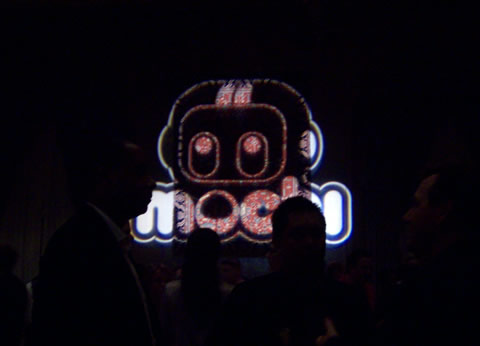
Here's Mochimedia's booth. They were pushing their new MochiCoins in-game microtransaction system with a pile of chocolate coins and some flyers featuring codes for free MochiCoins.
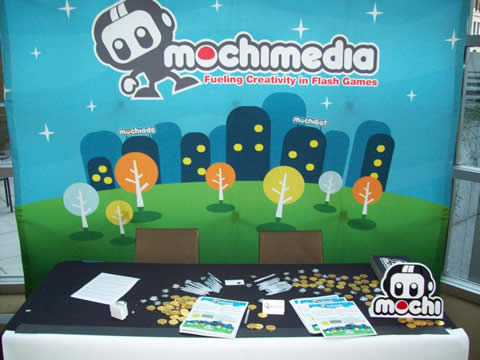
Casual Connect - Thursday
Thursday, the last day, is when everybody's tired. The big parties are usually scheduled before the last day to ensure that everybody's been up too late and is tired and/or hung over. If you ever want to do a conference session but you're worried about having too large an audience, be sure to hold it on the last day when everything's sparsely-attended.

Thursday's overwhelming 9am keynote attendance.
But your intrepid reported was bright-eyed and bushy tailed for the 9am keynote!
Mike Peronto - CEO of WildTangent "Playing with Games"
WildTangent started out as an advergame company, but they're now exclusively downloadable content
Business Model Basics
- Not all consumers are the same
- Thus not all games are the same
- Therefore you must optimize revenues
- When models don't work, you often look for short-term solutions without regard to long-term repercussions.
Avoid one-dimensional models. When great games are valued the same as lower-priced (and lower quality) games, then you're at a race to the bottom.
Look into multi-dimensional models. And his example of a multi-dimensional model is the entertainment industry. It's available in several models. . .
- Free - Hulu, broadcast TV
- Purchase - Buying movies on disc.
- Rental - Movie theaters, NetFlix. They have no conception of "ownership" associated with them.
Free is not really free. A third-party is paying for you to view the product. It's good for recessionary times. Comparing the free movie-models with the free game-models, try-n-buy games are up 22% while the standard boxed retail games are down 23%. Free leads to higher consumer revenue thanks to greatly increased exposure.
As for purchases, the best games have the highest conversation rate.
Finally, game rentals. Consumption models for game rentals all revolve around micro-currency. Lots of "free to play" MMO's with purchase-able items can be considered rentals. This model works better overseas where the concept of "ownership" and the physical box doesn't carry as much value. It's a good model if the consumer doesn't value a game as much as the full retail price reflects.
Advertising models have good news and bad news. The good news is that premium advertising for games is booming. The bad news is that high volume and low quality advertising is cratering. Taking the long view, there is $50 billion that will be spent on TV ads, and games are perfectly positioned for this.
As a case study. WildTangent released "wild coins", which are a microtransaction currency that can be used to rent or purchase games. The rentals ended up happening at 3X the purchase rate even when "full buyout" purchases were available.
In summary, the gaming industry is well-positioned to thrive, and there's a strong outlook for premium advertising and microcurrency-based rentals.

WildTangent's ORB booth, pimping game rentals for your downloadable content. Also a couple of freebie games to take home. Don't mind if I do.
My Meetings
One thing you can guarantee if you're press is meetings. Press-agents are more than happy to pester you to learn about a client's new product. I tried to avoid meetings that weren't germane to game development so I could concentrate on stuff you'd want to see. And I got a couple of interesting bits here and there.
Meeting with TrialPay
TrialPay is an established (three years old) payment solution for products purchased over the internet, but their "get it free" virtual currency solution is something new. Basically people can purchase products the "old fashioned" way (credit card, PayPal, etc.) or they can get their purchase for "free" by signing up to special offers, filling out surveys, etc.
Payouts are mapped to an exchange rate. Once the retailer determines and item's price, TrialPay will post the offers that are compatible with that item. With retailers, the price will be based on the amount spent. Payments are then made to the developer monthly.
As mentioned above, while the "free" thing is new. TrialPay still supports the traditional payment solution model. Hence TrialPay can be used as a standard commerce "back end" for people who just want to get out their credit card and buy something.
Another TrialPay feature is that they can post premium items for extra purchases, giving the user price-breaks for multiple purchases and (hopefully) a better incentive to purchase the product.
Meeting with Spil Games - Peter Hodstede
Spil Games is a global network of online casual game sites. They're fully localized with 50 different native-language sites. They're headquartered in the Netherlands with in-house development studios in the Netherlands and China. The in-house studios develop about 100 games per year, and the rest are licensed from third-party casual game developers. The lion's share of the content they license is in Flash, but Shockwave (Adobe Director) is acceptable if your submission requires a lot of 3D.
Since Spil's sites are localized worldwide, a game that can be easily localized is preferable to one that's not. Their biggest localized hits right now are licensed and localized versions of the "big" games, like their new fully-localized versions of Disney's "Club Penguin".
Club Penguin Localized for France
One thing they've noticed is that they're getting more mainstream console developers wanting to partner with them to create small-format casual games. Developers like having more control over the development process as well as faster turnaround times, so they're moving into the casual space.
Spil keeps an eye on games submitted to flashgamelicense.com, so if you want their attention, you might get it there. To contact them directly, email partners@spilgames.com.
What makes a success on their portals?
- Don't make things take too long to start. You can have a back-story, but it must have an initial "pull" that gets the user's attention rather than just tangentially-related material.
- Don't just make games that you want to play. The female market in casual gaming is huge, so take it into account. One of their big successes recently are 3D "dress up" games in which you can
dress up a character and then look at her from several angles in the "room".
- If your game is difficult, give the user some success straight away. Save the extra difficulty and depth for later on.
- Give early audio and video feedback and early encouragement to the user so they know they're playing the game correctly. Don't be too harsh if they're not.
- Games where users are allowed to build and share content, like the "line rider" drawing games, are very popular right now. Look into 'em.
Why choose casual game development?
- If you're an independent Flash game developer, you'll get more projects and more success. And if you're good at it, you'll have some financial success.
- Developing quick stuff on a quick schedule can be rewarding.
- Their most successful game got 20 million hits last month. And even if your game is simple, 20 million plays is a pretty hefty ego gratification.
Meeting with Arkadium
On Wednesday morning, I had a chance to get a quick meeting with Arkadium. They're an online games platform/portal/page, and they've been working closely with other non-game brands. Their more recent successes have been games for AARP and Hearst Publications. Most of their games were standards (Sudoku) that were then re-branded to fit in with the portals. The portals themselves work more as a general "experience" than concentrating on individual games. They also work with the existing sites' user profiles in the communities for things like shared high score tables. They work to ensure that their games are a "seamless" experience for the user.
They've also put together some share-able widgets. One of their successes is a WebMD-branded allergy calculator.
As far as outside submissions go, they're pretty-much a client-driven pipeline. So unless you just happen to have exactly what the client wants, they probably won't be very interested in outside submissions.
Their audience strongly leans towards women, and they've noticed that their audience prefers hidden-object and card games. While their audience leans towards women, the games themselves don't tend to. They let the content be driven by the site itself and let the games be gender-neutral. Some of the content is strongly gendered (i.e. Cosmopolitan magazine), but the games generally aren't.
As for advice for developers, don't put your eggs in one basket. Look at the opportunities that are out there. Look at the content that you have, and try to make the most of it.
The take-away message is "diversify".
Similar to the Spil Games interview, I get the impression that developers are still strongly male and tend to make content that appeals to males, despite casual gaming having a very strong female audience. So get outside the "I only make games that I play" mold and grow your audience.
Meeting with Oberon
Oberon is a holding company (i.e. a company that mainly owns other companies). One of their highest profile jobs is as a content provider for gaming portals. I remember talking to MSN games a couple of years ago, and their advice to game developers was to "get Oberon's attention" if you want to get your games on MSN's downloadable game portal. And I know this is the case for several other companies. If a company has "outsourced" their game submission process, it's probably to Oberon.
The publishing division inside oberon is iPlay.com, and it works as a more traditional "game portal" with downloadable as well as web-playable games. If you want iPlay's attention, you'll need to work through Oberon.
While this is interesting, what's of more interest to game developers is their new fully-automated online content management system called "Unity". The system's not yet ready for release (although there's a press-release here). Unity will be available Real Soon Now, and they're on the hook to get in touch with me when it does, so expect a review for gamedev.
Meeting with Scoreloop
Scoreloop is a newly-launched gaming community and game library (what I guess is now called "middleware" by the danged kids nowadays) developer. Their newest product is a global high-score and challenge API for iPhone games. Linking to the Scoreloop API's gives your games access to global high score tables with "medals" as well as challenges and buddy-lists.
Challenges can happen within your buddy list or Facebook. Challenges are linked with a user's scores, so you do get an indication that you're about to challenge someone who's hopelessly out of your league. You can challenge people just for giggles or you can put "coins" on the line to make things a bit more interesting. Mind you, Scoreloop coins are considered "merit items" and don't have any real-world value. They're strictly used to rub your opponents' collective noses in your accomplishments. Although in the future, coins may be available for purchasing virtual goods.
Scoreloop is available in Scoreloop-enabled games as well as a (free) app in the iPhone App Store that manages challenges for you.
For programmers, the user interface is customizable. The default interface looks nice and "iPhone-ish" right out of the box, but you can re-skin things to get a more consistent look. The interface is fully localized and localized text is sent from the server, so international challenges are a bit easier than they could be.
Their most recent announcement is that they're partnering with Unity (version 1.1 and 1.0.3). While Unity 1.1 now can "break out" to the underlying iPhone SDK, the Scoreloop objects are native to Unity, thus making the process much smoother.
The Scoreloop SDK is free, and developers get a 50% share of any challenge-coins purchased. If you're interested in Scoreloop-enabling your games, there's a developer sign-up button on their web page.
Meeting with AddictingGames
AddictingGames.com is one of five key properties of Nickelodeon (itself a property of Viacom) and is aimed at teens. They post 12-15 new games per week. For the developer they offer credit (i.e. your name and a link back to your site) as well as sponsorships in the form of up-front payments and quarterly bonuses for top-performing games. For licensed content, they'll likely expect you to integrate branded assets as well as their own community features, like shared scores, scores of "friends" registered on the site, and/or the ability to create levels and send 'em to friends.
A major "event" that I, being the father of a seven year-old girl, got to see was the "AddictingGames Showdown" on Nickelodeon. They made up ten tongue-in-cheek categories that could be applied to Flash Games. The show broadcast on June 27 and was probably a "first" for television to become a platform for promoting Flash games. And, admittedly, one of the challenges was to make Flash games look exciting on television. While "Bloons" looks just fine in your web-browser, it's not exactly as awe-inspiring as the latest "Transformers" clips on TV.
Another interesting item that's popular on their site are "News Games", which are extremely quick games that are based on recent news items. Their most popular recent News Game was "Where's The Naughty Governor?", a silly hidden-object game based on the recent governor scandals. Other recent games were "Cheney Shooter" and "Land The Airplane In The Hudson". These games are developed in-house because they need an absurdly short turnaround time (2-3 days) to keep the topic timely.
AddictingGames is happy to talk to third-party developers, and getting their attention regarding your Flash game is as simple as clicking the "Submit a Game" link on the site. New to AddictingGames is their "Submit an iPhone" game button, as they're expanding their reach from browser-based Flash games to iPhone.
AddictingGames will most likely get back to you with playability and tuning issues needed to make your game a good fit for the site. They also have "stinger" animations and watermarks you can use.
Since Flash game "theft" for other portals has become such an issue, AddictingGames opened up the door and created their own "embedded game program" with all the code necessary to embed games on your own site. Since the branded games link back to AddictingGames, there's still value in letting others use the content.
What AddictingGames is looking for are games that take 2-7 minutes to play. Rather than instructions, you should be able to get along with trial-and-error until you get a proper "feel" for the gameplay.
Coda - Pictures and Miscellany
One fun thing I got to do was participate in a "game show". The GSN WorldWinner people were showing off their new "Head To Head" version of Bejeweled, Bejeweled Twist. It's a bit like standard Bejeweled, although you can bet actual money at it.
Unfortunately, I was clobbered by my opponent and ended up taking home a consolation prize, a box of Rice-A-Roni. And a $10 gift card from Starbucks, as nothing goes better with chicken-flavored carbs than coffee!
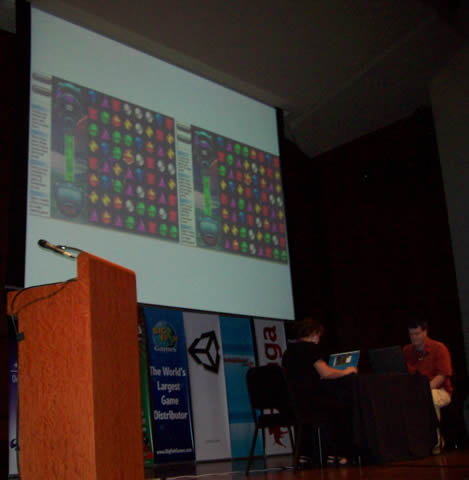
As with all trade-shows, everything was about freebies. And there were fun freebies to be had. Probably the funniest freebies were cans of "Brain Ooze" that PopCap handed out to push their latest Tower-Defense game "Plants Vs. Zombies". Here's the label.

The Fun-Dead Energy Drink! Tastes like a mixture of Red Bull and. . .Red Bull.
PopCap even had a genuine zombie on-hand. Thankfully, he was apparently so hopped up on Brain Ooze that he didn't have time to eat your reporter's brain.

GSN had the "serve yourself" candy machine there. After all those MochiCoins, though, I've had enough candy.
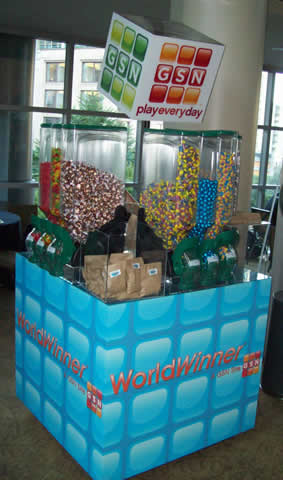
Least-inspired freebie had to be the T-shirt I got from the Namco booth. While they had a couple of cute toys available, the idea that a publisher with as much character IP as Namco handing out plain white T-shirts with a little red "Namco" on the front was disappointing. It's almost as if they were saying "Hey, we know you're gonna use it as a car-wash rag when you get home, so we didn't muck it up with a big decal."

During lunchtimes, I tried to avail myself of Pike Place, which is Seattle's fish/flower/coffee/tourist district. It's only a couple of blocks from Casual Connect, and it's a must-see. It's apparently built into a hillside, so it's several labyrinthine levels of shops. I rather wish I had one of these near me because all of the fresh fish and fruit and vegetables were beautiful.

My plane didn't leave until Friday afternoon, and I did the Space Needle last year, so I took Friday morning off to visit the Science Fiction Museum. I got to see lots of cute movie props and space-guns and other chunks of my childhood. They also had an exhibit of Muppet memorabilia, so I got a chance to see such cornerstones of my childhood as Kermit and Bert and Ernie in the "flesh".

If you're running the new Windows 7 release, the picture below might look a bit familiar. The Science Fiction Museum and Experience Music Project are housed in a giant oddly-shaped building that's clad in riveted-together chunks of randomly shaped and colored sheet metal. One of the default pieces of wallpaper in Windows 7 is a close up of the building.
Just thought it was interesting.

